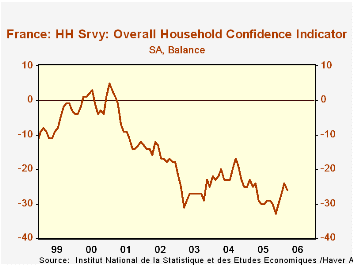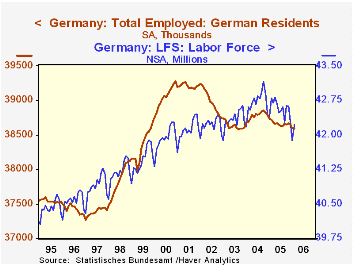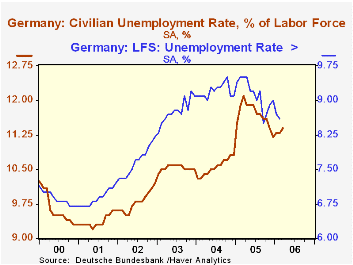 Global| Mar 30 2006
Global| Mar 30 2006French Consumers Look for Higher Unemployment; German Jobs and Unemployment Little Changed in Latest Labor Data
Summary
Labor policies are at the fore currently in France and Germany. France, as it tries to modify its basic "lifetime employment" work arrangements, faces massive riots by people at the other end of the economic spectrum -- who basically [...]

Labor policies are at the fore currently in France and Germany. France, as it tries to modify its basic "lifetime employment" work arrangements, faces massive riots by people at the other end of the economic spectrum -- who basically benefit from this policy -- from the young people who rioted last autumn because, due to this policy, they can't get a foot in the employment door. The government's proposal for a probationary employment period for young workers may sound good to these latter people, but it is not at all popular with current workers.
So today, the French statistics agency, INSEE, published the March household confidence survey. Does it show a reaction to these developments? Mildly so, and very specifically. The overall sentiment measure fell 2 points to -26 in March from -24 last month. These are both better than the November survey, in the midst of the labor disturbances; that figure was -33, down 3 points from October and the worst reading of the year, which averaged -28. So the current readings look "good" by comparison.
Two components showed some impact that may be related to these current disputes. Expectations about living standards fell 5 points this month to -38. In November, as well, this measure fell noticeably, to -43 from -37 in October. Expectations about unemployment also worsened each time: the new reading is +41 (meaning that 41% more people believe unemployment will increase than believe it will decrease), up sharply from February's +12. In November, by contrast, expectations about unemployment did not change from October's +20 value. Apparently, people see some fall-out from the government's current "probation" proposal, while they saw no implications from the November demonstrations.
In Germany, the February labor force survey (LFS) was reported today, along with "registered" unemployment for March. In the LFS, employment remained stagnant, increasing a mere 5,000 from January's level; since mid-2003, the number of people employed has hovered in a narrow range around 38.6 million. Despite the flatness in the number of workers, unemployment rates have generally drifted lower. The rate according to the ILO definition, which is similar to that used in the United States, was 8.6% in February, down from 8.7% in January and from several months a year ago that were at or near 9.5%. The ILO definition is standard to all the Euro-Zone countries. The more widely watched local German measure, "registered" unemployment is also below year-ago levels, although it ticked up to 11.4% in the March report; its recent low was 11.2% in December. Government and private commentators attributed the March increase to cold weather, which has limited seasonal hiring for outdoor work. They anticipate a rapid rise in hiring as temperatures rise.
The combination of stagnant employment conditions and downtrends in unemployment rates is clarified through developments in the labor force as a whole. As seen in the accompanying graph, it is declining, and is down by about 1 million workers since late 2004. This allows reported unemployment to go down, even if employment is not going up.
Germany too wants to liberalize its labor laws, and its leaders are sensitive to the violent situation in France. While German business confidence rose sharply this month, as documented here earlier in the week by Louise Curley, its political leaders are waffling in the face of the dilemma the strong reaction causes them. Each of the accompanying economic reports thus takes on greater weight in view of the high political stakes.
| Mar 2006 | Feb 2006 | Jan 2006 | Year Ago | 2005 | 2004 | 2003 | |
|---|---|---|---|---|---|---|---|
| France: Overall Household Confidence (%) | -26 | -24 | -27 | -25 | -28 | -22 | -27 |
| Living Standard, Next 12 Mos. (%) | -38 | -33 | -37 | -34 | -37 | -27 | -38 |
| Unemployment, Next 12 Mos. (%) | +41 | +12 | +15 | +57 | +39 | +49 | +68 |
| Germany LFS | |||||||
| Employment (Mil.) | 38.604 | 38.599 | 38.719 | 38.668 | 38.779 | 38.631 | |
| Unemployment Rate (ILO) (%) | 8.6 | 8.7 | 9.5 | 9.1 | 9.2 | 8.8 | |
| "Registered" Unemployment (%) | 11.4 | 11.3 | 11.3 | 12.1 | 11.7 | 10.5 | 10.5 |
Carol Stone, CBE
AuthorMore in Author Profile »Carol Stone, CBE came to Haver Analytics in 2003 following more than 35 years as a financial market economist at major Wall Street financial institutions, most especially Merrill Lynch and Nomura Securities. She had broad experience in analysis and forecasting of flow-of-funds accounts, the federal budget and Federal Reserve operations. At Nomura Securities, among other duties, she developed various indicator forecasting tools and edited a daily global publication produced in London and New York for readers in Tokyo. At Haver Analytics, Carol was a member of the Research Department, aiding database managers with research and documentation efforts, as well as posting commentary on select economic reports. In addition, she conducted Ways-of-the-World, a blog on economic issues for an Episcopal-Church-affiliated website, The Geranium Farm. During her career, Carol served as an officer of the Money Marketeers and the Downtown Economists Club. She had a PhD from NYU's Stern School of Business. She lived in Brooklyn, New York, and had a weekend home on Long Island.





